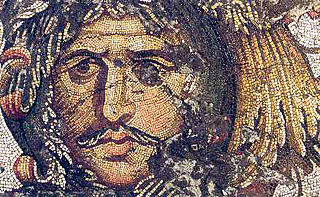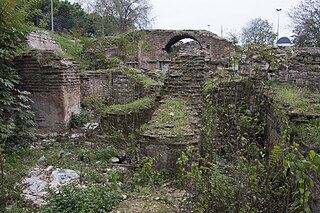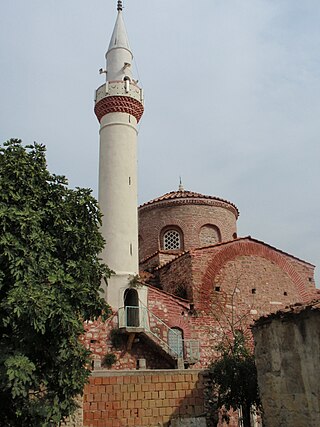Related Research Articles
Byzantine art comprises the body of Christian Greek artistic products of the Eastern Roman Empire, as well as the nations and states that inherited culturally from the empire. Though the empire itself emerged from the decline of Rome and lasted until the Fall of Constantinople in 1453, the start date of the Byzantine period is rather clearer in art history than in political history, if still imprecise. Many Eastern Orthodox states in Eastern Europe, as well as to some degree the Islamic states of the eastern Mediterranean, preserved many aspects of the empire's culture and art for centuries afterward.

The Great Palace of Constantinople, also known as the Sacred Palace, was the large imperial Byzantine palace complex located in the south-eastern end of the peninsula now known as Old Istanbul, in modern Turkey. It served as the main imperial residence of the Eastern Roman or Byzantine emperors until 1081 and was the centre of imperial administration for over 690 years. Only a few remnants and fragments of its foundations have survived into the present day.
Cyril Alexander Mango was a British scholar of the history, art, and architecture of the Byzantine Empire. He is celebrated as one of the leading Byzantinists of the 20th century.

Lazarus, surnamed Zographos, is a 9th-century Byzantine Christian saint. He is also known as Lazarus the Painter and Lazarus the Iconographer. Born in Armenia on November 17, 810, he lived before and during the second period of Byzantine Iconoclasm. Lazarus was the first saint to be canonized specifically as an iconographer. He was later followed by Saint Catherine of Bologna.

Ernst Kitzinger was a German-American historian of late antique, early medieval, and Byzantine art.

The Hodegon Monastery in Constantinople was allegedly founded by Saint Pulcheria (399–453), a daughter of Emperor Arcadius. The monastery is considered one of the three main Marian foundations built in the city along with the Blachernai and the Chalkoprateia.
Euchaita was a Byzantine city and diocese in Helenopontus, the Armeniac Theme, and an important stop on the Ancyra-Amasea Roman road. In Ottoman times, Euchaita was mostly depopulated, but there was a remnant village known as Avhat or Avkat. Today the Turkish village Beyözü, in the Anatolian province of Çorum, partly lies on the ruins.
The Nea Ekklēsia was a church built by Byzantine Emperor Basil I the Macedonian in Constantinople between 876 and 880. It was the first monumental church built in the Byzantine capital after the Hagia Sophia in the 6th century, and marks the beginning of the middle period of Byzantine architecture. It continued in use until the Palaiologan period. Used as a gunpowder magazine by the Ottomans, the building was destroyed in 1490 after being struck by lightning. No traces of it survive, and information about it derives from historical accounts and depictions.

The Church of St. Polyeuctus was an ancient Byzantine church in Constantinople built by the noblewoman Anicia Juliana and dedicated to Saint Polyeuctus. Intended as an assertion of Juliana's own imperial lineage, it was a lavishly decorated building, and the largest church of the city before the construction of the Hagia Sophia. It introduced the large-scale use of Sassanid Persian decorative elements, and may have inaugurated the new architectural type of domed basilica, perfected in the later Hagia Sophia.

The Fatih Mosque is a mosque in Tirilye (Zeytinbağı), Bursa Province, Turkey. The structure was originally constructed in the 8th or 9th as a Byzantine church and was later converted to a Muslim place of worship during the 16th century. It again served as a Greek Orthodox church between 1920 and 1922 until it was re-converted to a mosque in 1923.

Mangana was one of the quarters of Byzantine-era Constantinople. Located on the easternmost edge of the Sirkeci peninsula in which the city is located, it housed an imperial palace, arsenal and several churches and charitable establishments throughout the middle and late Byzantine periods.

Robin Sinclair Cormack, FSA is a British classicist and art historian, specialising in Byzantine art. He was Professor in the History of Art, Courtauld Institute of Art, University of London, 1991–2004.

Yoram Tsafrir was an Israeli archaeologist. His research has included the Byzantine influence on ancient synagogues, demography of Palestine in the Byzantine period, mosaics at Horvat Berachot, excavations at Beit She'an, and excavations at Rehoboth. A Professor Emeritus of the Institute of Archaeology at the Hebrew University of Jerusalem, he was a member of the Israel Academy of Sciences and Humanities.
Doula Mouriki was a Greek Byzantinologist and art historian. She made important contributions to the study of Byzantine art in Greece.

Byzantine units of measurement were a combination and modification of the ancient Greek and Roman units of measurement used in the Byzantine Empire.

The Kaper Koraon Treasure is a Byzantine silver treasure consisting of 56 individual silver items originating from Syria in the sixth and seventh centuries.
Erica Cruikshank Dodd is a Canadian academic who has published several studies on Byzantine, Middle Eastern and Islamic art. She was Professor of Byzantine and Islamic Art at American University of Beirut, Lebanon, and at the University of Victoria, British Columbia, Canada.
Henry Maguire was born in Bath, England in 1943. He is an art historian, specialising in Byzantine art, and Professor Emeritus at Johns Hopkins Krieger School of Arts and Sciences in the History of Art Department. Between 1991-1996, he was Director of Byzantine Studies at Dumbarton Oaks, a research institute of Harvard University.
Alice-Mary Talbot is director of Byzantine studies emerita, Dumbarton Oaks Research Library and Collection. Her particular expertise is the social context of Byzantine religious practices, including hagiography, monasticism and gender studies. Much of her work has focused on the edition and translation of Byzantine texts.
David Crampton Winfield MBE was a British conservator and Byzantinist who specialised in wall paintings. The first part of his career was spent abroad, mainly in Turkey and Cyprus, and he was awarded an MBE in 1974 for his conservation work in Cyprus. In his obituary in The Times, David Winfield was described as “an investigative archaeological explorer cast in the mould of the great 19th-century scholar-travellers”.
References
- 1 2 3 4 5 DISCIPULI DONA FERENTES : glimpses of byzantium in honour of marlia. [S.l.]: BREPOLS PUBLISHERS. 2017. ISBN 9782503575858. OCLC 993760610.
- ↑ "Dr Marlia Mango".
- ↑ Anna Bonnell-Freidin (1 August 2009), Cyril Mango and Marlia Mundell Mango, Dumbarton Oaks Research Library and Collection
- ↑ Marlia Mango - School of Archaeology, University of Oxford
- ↑ "About the Fellowship".